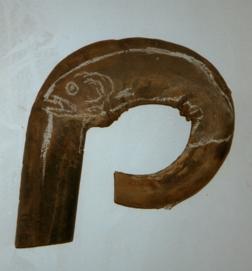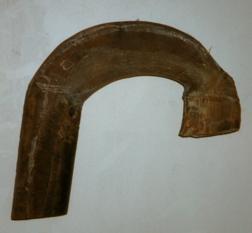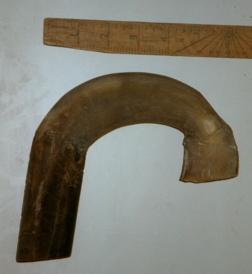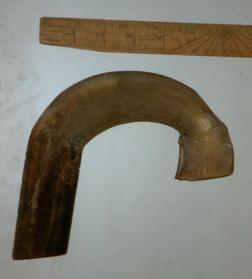 |
I have roughly drawn the trout on the horn
in chalk, but if you wish to have the image for a longer period
the indelible felt tip pen works. I am not an artist and by using
chalk I can remove the wrong lines easily.
The end of the horn now needs cutting off
just below the fish's tail; this can be done with a hacksaw,
coping saw or bandsaw.
|
|

|
The
horn has been removed and one can see the white pith in the centre
of the horn; this is softer than the horn and needs to be removed
by heating and squeezing. |
|

|
The
horn must be heated all around the tail area and squeezed in
the vice. Again it may take several attempts to flatten it depending
on the thickness of the horn and the pith. Care must be taken
when squeezing not to allow the tail to twist too much out of
line. |
|

|
The next step is
to get the inside line of the handle, whihc in this case is the
belly of the fish. I achieve this by using a ten inch half round
file. For maximum removal of horn I use a dreadnought file; it
is better than a rasp and it does not make grooves. Using a large
file does tend to ensure the curve is regular and smooth. |
 |
I have now worked
the top line of the fish down, remembering to leave a little
bit of horn above the tail to carve the pelvic fin. By laying
the head down the way I want it to look on the finished stick
I find that I have committed the mistake I mentioned above and
not squeezed it enough to make the fish at less of an angle to
the shank part of the head. |
 |
I have
heated the horn very gently, (but still to the required temperature
to achieve the compression of that part of the horn,) around
in the angle where the bottom of the fish joins the shank part
of the horn and squeezed it in the sash cramp as before. The
difference in alignment compared to the above picture can easily
be seen. It is very easy to burn the horn at this stage and there
is very little horn left to remove to eliminate the burning. |

